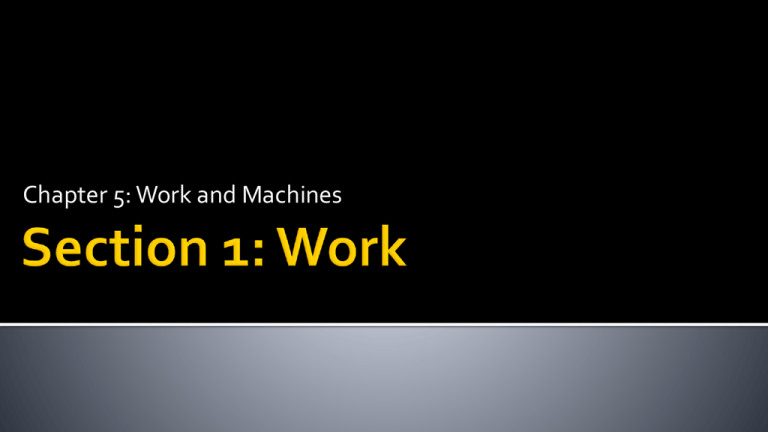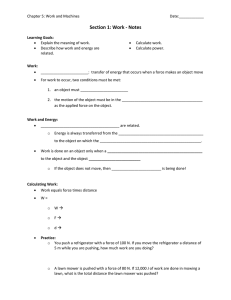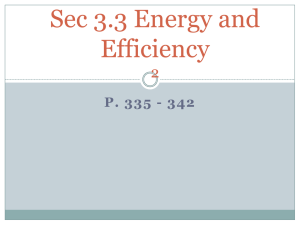Chapter 5: Work and Machines
advertisement

Chapter 5: Work and Machines Compare the effort exerted by a backpacker moving over level ground to that exerted by a backpacker moving uphill. How do you think the weight of the backpack affects the amount of force needed to move it? Explain the meaning of work. Describe how work and energy are related. Calculate work. Calculate power. Work: transfer of energy that occurs when a force makes an object move For work to occur, two conditions must be met: 1. an object must move 2. the motion of the object must be in the same direction as the applied force on the object. Work and energy are related. Energy is always transferred from the object doing the work to the object on which the work is being done. Work is done on an object only when a force is being applied to the object and the object moves. If the object does not move, then no work is being done! Work equals force times distance W = Fd W work, measured in joules (J) F force, measured in newtons (N) d distance, measured in meters (m) W = Fd F = W/d d = W/F You push a refrigerator with a force of 100 N. If you move the refrigerator a distance of 5 m while you are pushing, how much work are you doing? A lawn mower is pushed with a force of 80 N. If 12,000 J of work are done in mowing a lawn, what is the total distance the lawn mower was pushed? The brakes on a car do 240,000 J of work in stopping the car. If the car travels a distance of 50 m while the brakes are being applied, what is the force the brakes exert on the car? Suppose you give a book a push and it slides along a table for a distance of 1 m before coming to a stop. Work is only being done to the book when your hand is in contact with it! You would not use 1 m in the equation, you would use the distance the book moved while your hand was touching it. Power: amount of work done in a certain amount of time rate at which work is done Power equals work divided by time. P = W/t P power, measured in watts (W) W work, measured in joules (J) t time, measured in seconds (s) P = W/t W = Pt t = W/P You do 900 J of work in pushing a sofa. If it took 5 s to move the sofa, how much power did you use? If a runner’s power is 130 W as she runs, how much work is done by the runner in 10 minutes? The power produced by an electric motor is 500 W. How long will it take the motor to do 10,000 J of work? Doing work is a way of transferring energy from one object to another. Power is the rate at which work is done Power is also the rate at which energy is transferred Power equals energy transferred divided by time. P = E/t P power, measured in watts (W) E energy transferred, measured in joules (J) t time, measured in seconds (s) P = E/t E = Pt t = E/P A color TV uses 120 W of power. How much energy does the TV use in 1 hr? Describe a situation in which a force is applied, but no work is done.


